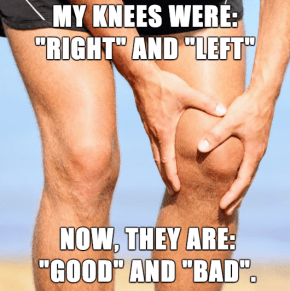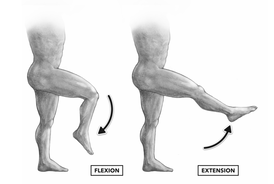
One of the most commonly injured body regions that we encounter are the knees! We get asked all the time the best stretches, mobilizations, or treatments for the knee and the truth is… the knee more often than not the VICTIM, not the cause of your pain. This means that the best treatment for the knee is to address the ACTUAL cause, whether that be the mobility of your hips or ankles, strength imbalances, or movement impairments. Sure, issues will likely occur at the knee itself, which we’ll cover in a moment, but if you ONLY address the knee, you likely won’t get the results you’re looking for!

Let’s start with talking about some anatomy. The knee is a simple hinge joint, much different than the hip, which is a ball and socket joint. Ball and socket joints afford much more motion than hinge joints. Think of all the ways your hip can move – it can rotate, move forward, back, out to the side, across your body… just to name a few. Hinge joints do exactly what it sounds like, they hinge back and forth much like a door on a hinge at your house. While hinging back and forth is the main motion of the knee, there actually is a small amount of rotation that occurs as well. When that rotation becomes excessive, it leads to pain. More specifically, we see excessive rotation into external rotation and a lack of rotation into internal rotation. This is most often seen as the inward collapse of your knees in relation to your hips and ankles or outward pointing of your toes when going up and down stairs, standing up from a chair, or squatting. Reducing this excessive knee rotation into external rotation can significantly speed up recovery! These are our top 5 exercises to address this common issue!
1. Tibialis Raises
This exercise targets the tibialis anterior which is the muscle on the front of your shin, directly below the knee. It is the main muscle responsible for dorsiflexing your ankle, bending your ankle up toward the sky. It is also the decelerator of your foot and prevents your foot from slapping the ground when you walk. This muscle is a common culprit for shin splints and is usually weak in most people. The stronger you are in this muscle, the less pain you’ll have in the shins and knees because you’re building strength and stability from the ground up.
2. Big Toe Calf Raises
Your ankle mobility plays a HUGE role in determining the health of your knee. If your ankles don’t move well, your knee is the next joint in line to pick up the slack causing it to overwork and break down. This deficit heel raise adds a stretch to your calf to directly work on your ankle mobility, while strengthening some important muscles in and around your knee and ankle. The target of strengthening is your gastroc-soleus complex and FHL (a powerful muscle that flexes your big toe and helps to stabilize your ankle when your weight is on the ball of your foot).
Whatever forces are not absorbed by the ankle will have a direct effect on the knee, so the stronger we can make these muscles, the less pain you’ll experience.
3. Posterior Hip Capsule Self-Mobilizations
Addressing the hip joint is a MUST for those that sit all day and deal with knee pain. When we sit, hip flexion (or the knee to chest motion) becomes limited primarily from tightness in the hip capsule or joint. Loosening up this joint from multiple angles will allow the hip to move more freely and take pressure off the knee joints.
4. Tibial Internal Rotation Self-mobilizations
This is a self-mobilization that addresses the excessive rotation that occurs in the knee joint. It helps to restore the internal rotation needed when bending (flexing) the knee. A deficit in internal rotation is a common cause of knee pain, especially when squatting, lunging, or performing anything that bends the knee.
5. Banded Side Steps and Squats / Single Leg Medicine Ball Airplanes / Single Leg RDL + Lunge Combo
Improving glute strength and stability is CRUCIAL when dealing with knee pain. Your glutes are the main muscles responsible for controlling how healthy your knee moves. When these muscles are weak, they contribute to the inward collapse and excessive rotation in your knees that commonly lead to pain, commonly known as valgus. If you can improve the stability and strength of your glutes, you’ll then improve the stability and control of your knee. This leads to less pain overall.
In addition to implementing these 5 exercises above into your weekly routine, you’ll want to improve your movement patterns for long term success. Avoiding excess valgus movements is KEY. It’s this movement pattern that, when done repeatedly, leads to the most common root cause of knee pain – excessive tibial external rotation. Check out this blog, Top 5 Reasons Knee Valgus is Bad for You to learn more about this movement pattern.
I also want to mention that it’s okay, infact recommended, to allow your knees to translate over your toes when squatting. This is a normal motion that is needed to perform a healthy, pain free squat. BUT, you have to have the mobility and strength to do so. By addressing the impairments that cause you to move into valgus and prevent your knees from translating over your toes, you’ll be on your way to restoring health in your knee.
Lastly, be sure to train through full ranges of motion (ie. squatting below parallel). Joints that are not trained through their full range will become stiffer, and weaker over time. Have noisy knees? The term “motion is lotion” holds true and applies here as well! Now, noisy knees aren’t usually a cause for concern, check out this blog to learn more – My joints crack and pop. Is that bad? But, the more movement and deeper ranges of motion you can perform without pain, the more lubrication and nutrition you’ll diffuse into your knees. The muscles, tendons, and ligaments surrounding the knee joint will become stronger if you use them to their full potential!!
Final Word
If you’re experiencing knee pain, you’re not alone. This is a COMMON issue that CAN be addressed. (NO, bad knees are NOT genetic). Start implementing the info from above right away to get you on the right path. While this is the most common movement impairment in the knee, it’s not a one size fits all approach. If you’d like a more individualized evaluation, game plan, and customized treatment, don’t hesitate to reach out! We work with athletes just like you everyday (locally and around the country) and specialize in getting athletes back to their sport without limitations! We’d love to help!
Thanks for reading!
-Dr. Aerial


2 Responses
Hi I’m Adam and a ultra runner and been suffering a meniscus injury since July is there anything you can give me to help the problem and bullet proof my knees. Thank you
Hey Adam, sorry hear about your knee. Unfortunately we would need more information and likely an assessment in order to provide specific advice for your knee. If you’re interested, we’d be happy to do a virtual session with you – just head to the main webpage and picka time and day that works best! – Dr. Andrew